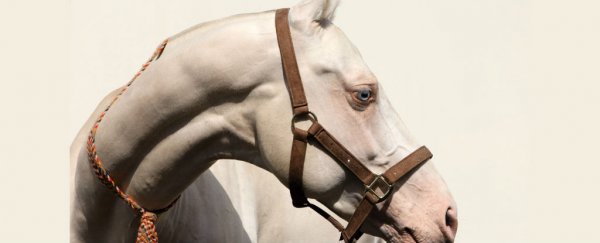Scientists have made some big assumptions when it comes to explaining the rapid evolutionary success of horses over the past 18 million years - and based on a new analysis of teeth and body sizes, they might have gotten some key details wrong.
Rather than evolving faster once grasslands became a viable habitat, and developing stronger teeth and bigger bodies to deal with their new grass-filled diet, the evidence reveals that, across 138 species, horses have actually changed very little to get where they are today.
"According to the classic view, horses would have evolved faster in when grasslands appeared, developing teeth that were more resistant to the stronger wear that comes with a grass-dominated diet," says one of the team, Juan L. Cantalapiedra from the Museum für Naturkunde in Germany.
Not only should their teeth change in response to a different diet, but according to classic view of evolution, horses would have also become bigger to more effectively digest this low quality food, and to protect themselves against predators in their new, open habitats.
But when Cantalapiedra and this team constructed a new evolutionary tree, tracing 138 current and extinct species of horse from 18 million years ago to today, they found that both their teeth and body sizes remained remarkably similar.
Using new computer models to map information on tooth and body size from 131 extinct and 7 living species of horse, the team was able to figure out where 'bursts' of speciation - the appearance of new species - occurred across millions of years.
They found three such bursts across the family tree, with the first occurring in North America between 15 million and 18 million years ago
Two more bursts occurred "when changes in sea level allowed their migration from North America into Eurasia and Africa, 11 and 4 million years ago", says one of the team, María Teresa Alberdi from Spain's National Museum of Natural Sciences.
The researchers expected to be able to compare these bursts of high speciation rates with times of low speciation in the family tree, and find evidence of 'adaptive radiation' in the fossil record to reflect that.
Adaptive radiation is a process in evolutionary biology that describes how species evolve new traits - such as teeth and body size - in order to branch out into new or unoccupied habits.
But when the team tried to match events of high and low species diversification with major changes in teeth and body size, they found that rates in body size evolution didn't differ all that much across the board, and teeth actually changed less during bursts of high speciation.
"This knocks traditional notions that rapid diversification of new species comes with morphological diversification as well," palaeontologist Bruce MacFadden of the University of Florida, who wasn't involved in the study, told Science News.
The team suggests that despite the fact that horses have long been held up as a "textbook" example of adaptive radiation, the evidence points to their experience being the opposite.
As Jana Howden explains for Cosmos:
"They found that migration patterns and changes in environment drove the development of new traits. This is the opposite of the prevailing theory of evolution, which holds that new traits - such as bigger teeth or a thicker pelt - develop first, allowing species to then move into new environmental niches."
"We'd always thought you can only really become species-rich by adapting to new environments, but here it seems that the new species comes first, and then the anatomy changes later," evolutionary biologist Alistair Evans from Monash University in Australia, who was not involved in the research, told her.
One explanation the researchers are keen on exploring is the idea that perhaps horses changed what they are before evolution caught up and resulted in physical changes in their teeth.
Or perhaps the grasslands were so expansive, that there was little competition for resources to drive the rapid proliferation of new traits.
What we do know is we've been assuming things about the evolution of horses that do not bear out in the evidence, and it's a timely reminder that often the reality of the situation is a whole lot more complex than the theory would suggest.
"It's very tempting to see some change in body size, for example, and say, 'Oh, that's adaptive radiation,'" Cantalapiedra told Science News. "But that's not what we see."
The research is published in Science.
